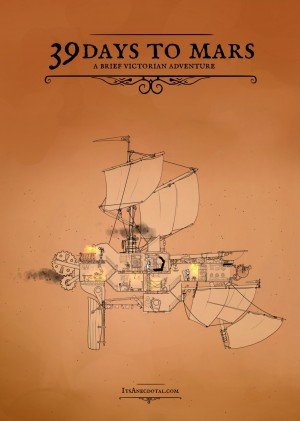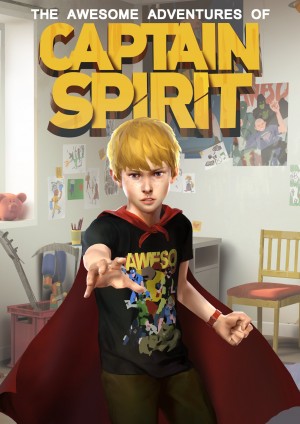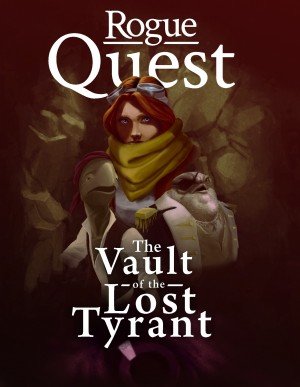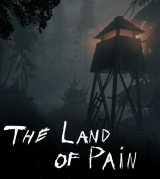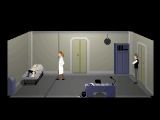Review for 39 Days to Mars page 2
I grew up in the golden age of adventures. Back then I’d get together with friends and we’d while away the hours hanging out playing games. Naturally, only one person could actually “drive” the experience, with the other sitting next to them providing suggestions of varying degrees of helpfulness. I remember thinking how nice it would be for both players to be playing at the same time. Thirty years later, developer It’s Anecdotal has given us the 2D co-op adventure 39 Days to Mars and… well, it’s not quite what I was hoping for.
39 Days feels inspired by both From the Earth to the Moon and Around the World in Eighty Days by Jules Verne, with its pseudo-Victorian steampunk feel. In it, you and a friend take on the roles of Sir Albert Wikes and Clarence Baxter, who decide one day, as gentlemen do, to travel to Mars. Albert is tall, skinny, and wears a top hat. Baxter is short, has a round head, and is useless without a scone and cup of tea. That’s the extent of characterization, as the game focuses more on the challenges the pair must overcome as they travel to the red planet – or rather, sepia-toned planet – in their homemade spaceship, the HMS Fearful, parked in the backyard.
During the journey, you do very little puzzle solving in the traditional sense. Instead, you are mostly confronted with various activities set up as discrete obstacles that need to be overcome. While there are a couple that fall into the puzzle category, needing some mental working-out, most of the scenarios make it obvious what needs to be done. The challenge comes in both players working together to make the interface do what needs to be done.
Prior to liftoff, Albert and Baxter need to chart a course to Mars. This is done by piecing together a torn-up sheet of paper. It’s a fairly typical task in adventure games, and one that’s usually quite easy to complete. Less so here. In 39 Days, when entering one of these close-up situations, both players are given a pointer to control, represented by a hand. To differentiate the hands, one of them has a wristwatch and the other doesn’t.
In this particular fit-the-paper-back-together puzzle, the pieces need to be rotated to the correct alignment. To accomplish this, one player must move their hand over one of the pieces to grab it. The other player then moves their hand over the same piece, grabs another part of it, and then rotates it about the first player’s hand. Once in the agreed-upon orientation, either player can drag the piece next to another piece and hope it connects. One snag with this is that the paper pieces can collide, bumping one another out of the way and altering their orientations. It all becomes rather cumbersome, especially when compared to similar challenges in single-player games. At any rate, this dual-hand system forms the basis for almost all of the situations encountered during the game.
The most awkward challenges you’ll encounter are also the ones 39 Days throws at you most often: preparing scones or tea for Albert. Once Albert and Baxter are on their way to Mars, a series of disasters begins striking the ship. Albert’s typical response to these is that they’re far too complicated to tackle without either a biscuit or a cuppa.
Unfortunately, preparing a scone is way more trouble than it should be. You are given a recipe indicating whether Baxter’s in the mood for one with strawberries, jam, a lot of butter, or some smorgasbord combination. The recipe changes with each scone you must prepare. The difficulty comes from being given a butter knife, which you and your friend must use to precariously lift chunks of butter and jam from a counter up to a raised plate. Each chunk is semi-physically modelled, meaning if you’re not careful and you bump the scone or an ingredient you’ve already set in place, you may set everything to tumbling. It doesn’t help that these sections, for whatever reason, tend to be quite glitchy, with one or the other hand suddenly spastically going off in a direction of its own, or higher-stacked ingredients spontaneously falling through lower-stacked ones, upsetting the delicate balancing act needed to mound up a scone to Baxter’s preference.
By comparison, preparing a cup of tea is much simpler, though not without its own difficulties. The main issue with the tea is that, depending on the recipe, Baxter prefers it at various temperatures: hot, warm, cool, etc. This is accomplished by filling the provided teacup with hot water and then either waiting for it to cool off or adding milk to hurry it along. Sugar can also be added if the recipe requires it. The challenge here is that the preparation is timed. Add a lump of sugar as directed, but take too long to finish adding the other ingredients and the sugar evaporates so the final mixture is no longer sweet. Coordinating the two hands is hard enough; it becomes just that much more frustrating once the time element is added in.
Between the fiddly bouts of scone and tea preparation, thankfully 39 Days does offer an impressive variety of other objectives. Throughout your journey to Mars, you’ll find yourself tending to an onboard garden, sending a Morse-type coded message, fixing leaky steam pipes, reconnecting an assortment of power cables, and manning the ship’s primary control panel, among other things. However, while the setups for all of these are different, they do tend to feel the same after a while, since all are dependent on the same co-op control method.
The close-up challenges are occasionally interspersed with scenarios that need to be dealt with in the hub environments of Albert and Baxter’s house at the beginning and the spaceship later on. These areas are viewed from a side-on 2D perspective that lets you see all the floors and rooms, and you move about them in typical side-scroller fashion. When you find a problem that can be worked on, you and your friend must both go to that area and hold down your respective activate buttons to access it.
While in these hub views, you must sometimes overcome different crises that strike, such as when small space squids start invading the ship. Here one player has to hit a button at the appropriate time to swing a butterfly net to catch nearby squids. Meanwhile, the other player is running around the ship with a spray bottle that is used to clean blotches of ink off the monitor so that your view of the attackers is not obscured.
The hub-based challenges require a degree of manual dexterity not typically required in the others, and usually incorporate some manner of timed element. For example, at one point the first player has to steer an EVA pod out into space while the other controls a mechanical arm attached to the pod to harvest passing asteroids for coal needed to fuel the spaceship. However, the EVA pod only has a limited amount of oxygen. Take too long to harvest the coal and the screen fades to black before placing you back at the start of the sequence to try again.
One interesting aspect of the various activities is that they typically involve some manner of randomness. For instance, when tending the ship’s garden, you have to ensure there is a correct number of different types of plants. You are presented with three rules, like needing exactly three hollies or an equal number of violets and hazelnuts. The particulars of these rules are randomized on each playthrough. So too is the layout of the HMS Fearful itself, as well as the order in which the obstacles are encountered. These arbitrary changes add a small dash of replayability to the game, although the journey itself is by and large the same.
For those who may have already played the game through once, another reason to fire up 39 Days again is its continued development since initial launch, offering more challenges to overcome. Interestingly, instead of adding a separate expansion-type storyline, the developers integrated the free new obstacles into the main storyline itself so that they fit seamlessly in with those already there. Not having played the game prior to the “Additional Victorian Adventure” update, I’m uncertain as to how much was added after the fact, but it’s certainly a nice touch.
Although the game has been designed as a co-op experience, it should be noted that there are no options for network play or playing over the internet. This means that if you want to play in multiplayer mode, you’ll need to find somebody to sit with you to be the second player. If there is no such person, you can either play in two-player mode by yourself (the only extra burden being having to move both characters in the hub screens) or you can run the game in single-player mode, in which only Albert goes to Mars and takes his cat with him. The cat operates as the second player and moves to whatever location it’s needed in the hub world. Tackling the different challenges solo, you still operate the hands for both players, basically controlling each of them yourself. And yes, you do still have to prepare scones and tea, for Albert this time instead of Baxter.
39 Days to Mars offers a wide range of control systems, including the mouse, keyboard and gamepad. I tried out all the different options and found the two-handed interface was cumbersome regardless of the method used. The mouse seemed to offer the best playability, although that’s only good for one player. In general, both players using the keyboard seemed to work best, but even then the default keys could use a little work. One player uses the WASD keys for movement and the space bar to activate/grab things while the other player uses the number pad and its 0 key for the same actions. Awkwardly, when entering a new challenge for the first time, the hand for the player using the WASD keys starts on the right side of the monitor, even though the keys are on the left side of the keyboard, and vice versa for the second player.
One thing to note when using the keyboard for both players is that there is also a “back” key that can be used to exit out of a challenge if so desired. For the second player, the back key by default is Num Lock, so pressing this key has the unfortunate side effect of then rendering the rest of the number keys unusable until Num Lock is pressed again. This messed me up a couple of times until I figured out what was going on, as I thought the game kept disconnecting the second player.
Related to the controls, and buried near the end of the options menu, is the game’s privacy policy. If you’re wondering what that is, you’re not alone as I had the same question. Accessing the privacy policy fires up a webpage that indicates your inputs are being recorded. This is intended to allow the developer to review how the game is played in order to, in theory, improve the experience over time. It seems harmless enough, but some players may be a little leery about letting their games “phone home” and report on them, and 39 Days doesn’t particularly go out of its way to draw attention to this fact.
There is no manual save option, which is usually a pet peeve of mine. However, as there is only ever one challenge to confront at a time, and each activity is quite short, the single progressive autosave works well here. On my own it took me three hours to finish the game, counting the time spent fiddling with the control settings to try getting them to work better.
With no ability to turn subtitles off, they’re always displayed as speech bubbles floating above the heads of Albert and Baxter. In multiplayer this makes sense, as it allows dialog from both characters to be seen at the same time when, for example, attempting to start challenges that aren’t accessible yet. Voices are provided for the two protagonists and are pleasant to listen to, though story and characterization aren’t important here so their comments back and forth are fairly limited. I found myself wishing they had more opportunities for conversation throughout the journey.
Along with the voice-overs are simple, somewhat cartoony sound effects that match the simple, somewhat cartoony look of the game. Visually, the background is a tea-stained wash of color with locations and close-up challenges drawn over top as simple black and white line drawings. A bit more differentiation here would have been nice, because in some scenarios it was initially hard to discern what elements could be interacted with just by looking at them. Instead it was necessary to move one of the hands around the screen to see which items became outlined in a thicker black border, the indicator for when something can be used. As for Albert and Baxter themselves, they’re one step above being stick figures and the look is quite charming.
The journey to Mars is accompanied by low-key, primarily piano-based tunes that can best be described as background drawing room music. There are a couple of instances where the music picks up, usually when running out of time during the different pressure sequences, but it never becomes blaring or over-the-top. It feels appropriate for two gentlemen on a road trip (or space trip, as the case may be) who don’t want to give up the creature comforts of civilization.
It’s hard to say who would most appreciate 39 Days to Mars. Although it has multiplayer support, the nature of the dual-handed gameplay means that coordinating efforts is actually slightly easier to do in single-player mode. Even so, battling the clunky controls means that the game isn’t quite as fun as it should be. It’s a shame too, as there’s a good collection of different scenarios to work through, the visuals are rather endearing, and the voices for Albert and Baxter are enjoyable. With so few co-op adventures available, there’s little precedent to model a successful game on, so it’s good to see an experiment like this. Hopefully It’s Anecdotal will continue exploring this largely uncharted territory, but next time just leave the scones behind and remember that the protagonists each have two hands of their own.


